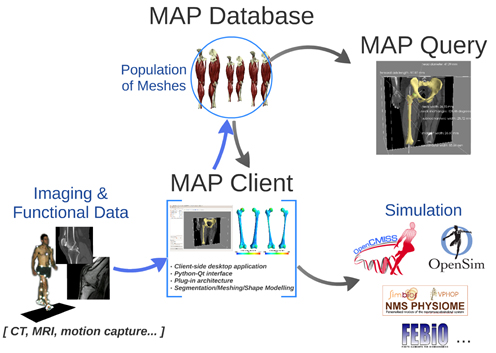Feb 23, 2016
Webinar: Patient-specific Model-building and Scaling with MAP and Statistical Shape Modeling
Learn about the workflow tool MAP and the methods it uses to improve and streamline patient-specific model-building and scaling
DID YOU MISS THIS EVENT?
A recording of the event is available for viewing, and the slides are available here. You can learn more about the Musculoskeletal Atlas Project (MAP) by browsing their documentation or downloading their code.Details
Title: Patient-specific Model-building and Scaling with the Musculoskeletal Atlas Project and Statistical Shape Modeling Speakers: Thor Besier and Ju Zhang, Auckland Bioengineering Institute, University of Auckland, New Zealand Time: Tuesday, February 23, 2016 at 2:00 p.m. Pacific Standard TimeAbstract
Subject-specific computational models of the musculoskeletal system have tremendous potential for clinical application. However, generating these models is time-consuming, costly, and requires high levels of expertise. Furthermore, the geometry of computational models used to investigate joint mechanics often do not map well to the rigid body models to estimate muscle forces. To address these issues, we have developed a Python-based, open source software platform called the Musculoskeletal Atlas Project (MAP). Our aim is to provide the biomechanics community with a tool that rapidly generates subject-specific models for computational modelling and also resolves some common issues encountered when scaling models.
In this presentation, we will discuss the challenges of generating and scaling subject-specific models, including registering experimental data, accurately capturing bone geometry, and dealing with subject-specific joints and muscle lines of action. We will describe methods implemented in MAP to solve these issues, including the use of Shape Models derived from large image datasets to constrain the scaling of bone geometry to match motion capture and/or medical imaging data. We will present some example workflows within MAP to scale a lower limb model and demonstrate how MAP's simple plug-in architecture facilitates customisation and community engagement.
Who should attend?
This webinar would benefit the following types of participants:
- Computational modellers who wish to generate subject-specific models that can be used for continuum mechanics and multibody dynamics simulations
- OpenSim users that are interested in a new tool to scale their models
Webinar highlights:
- A conceptual overview of our MAP Client software and our plan for future progress
- A description of how statistical shape models can be used to represent a population dataset and provide constraints to scaling OpenSim models
- An explanation of key methods used within MAP, including: Principal Component Analysis (PCA), PCA-fitting, registration between motion capture markers and medical imaging data
- An interactive discussion of scaling issues: accurately capturing bone geometry, muscle-tendon paths, segment and joint descriptions (joint centres and axes of rotation)
 Figure 1. MAP Framework. The MAP Client imports images and functional data and facilitates segmentation meshing using the MAP Database population. A MAP Query tool can determine anatomical features across the population. Meshes exported from the MAP Client are compatible with various simulation environments.
Figure 1. MAP Framework. The MAP Client imports images and functional data and facilitates segmentation meshing using the MAP Database population. A MAP Query tool can determine anatomical features across the population. Meshes exported from the MAP Client are compatible with various simulation environments.
